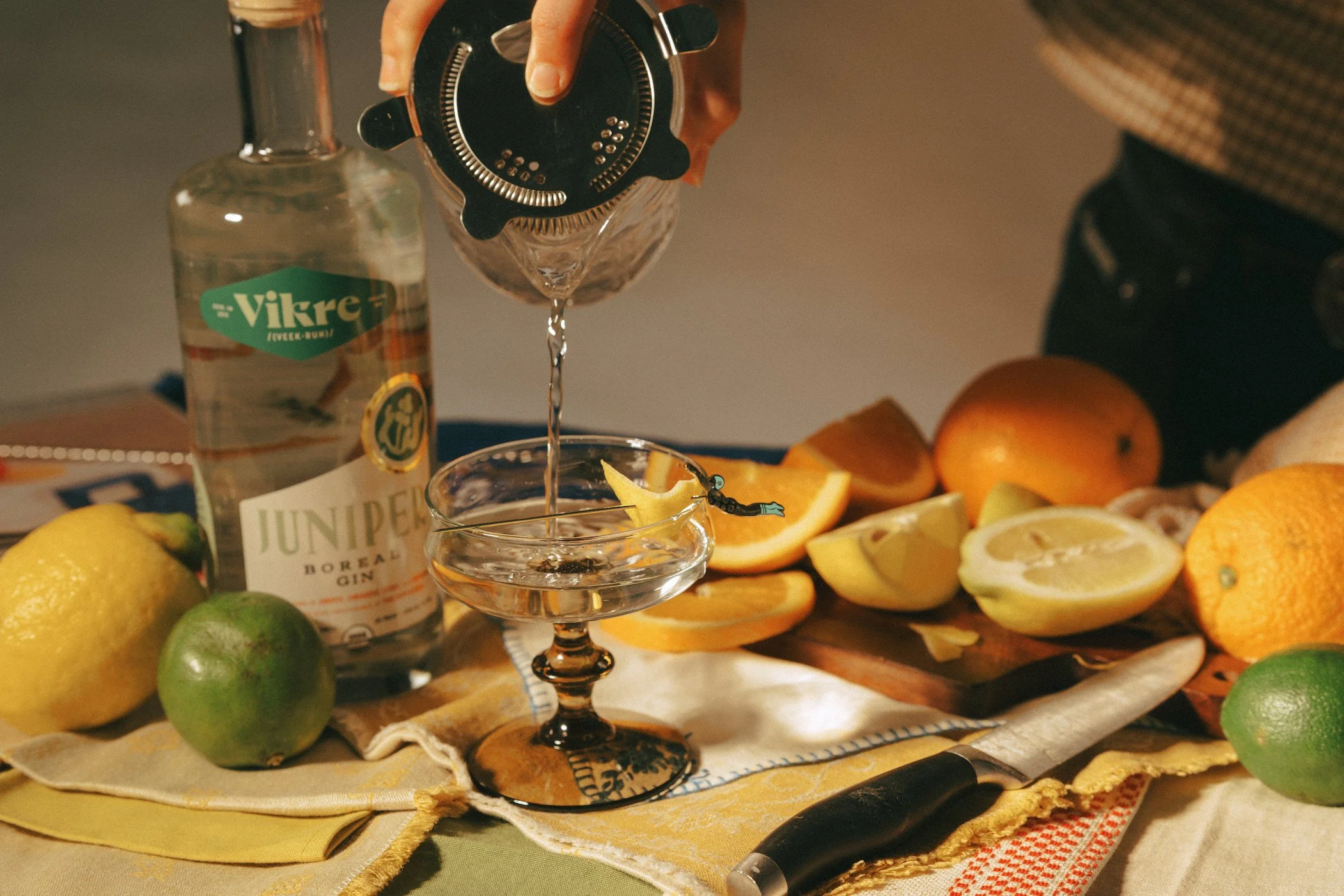The Ultimate martini line-up
From dry to wet to dirty
If someone says “cocktail,” what is the image of a cocktail that flashes into your mind’s eye? I’d hazard to guess that for many of us it is a martini, crystalline, leggy, perfectly garnished, and ever so sexy. I’ve been on an approximately 5 year journey from not liking martinis at all to martinis being my go-to cocktail. Whether you consider yourself a martini person or not (yet), the excellent news is, there’s not just one way to martini. Sure, this bartender or that drinks writer will tell you that there is a best martini, but honestly, I think the best martini is the one that speaks to you. As long as you use good gin! And we’re here to help with that ;). From there, there are a number of different ways to adapt a martini to your taste by wiggling the ratios or mixing in brines (olive or otherwise). In tribute to the queen of drinks, here is a whole “martini style guide” of the main variations of the martini to get you started!
Classic Dry Martini
What is the best gin for a martini? The most classic version of a martini leans heavily on the gin and begs for a very clean tasting gin that has strong notes of juniper berries. At the same time, you don’t want it to be harsh at all since it is the main player. As such, I think our Juniper Gin is simply perfect. While some people think that the dry in dry martini is a reference to using dry vermouth, calling it a dry martini actually indicates you want only a small amount of vermouth (a large amount of vermouth is a wet martini, and we will be coming to that shortly). While some people think that the amount of vermouth should be a mere whisper or even a “nod in the direction of France,” I don’t think a chilled spirit on it's own should really qualify as a martini. Plus I love vermouth. So make sure it’s in there! The orange bitters harmonize the gin and the vermouth.
2 oz. Juniper Gin
1/2 oz. dry vermouth
2 dashes orange bitters
Stir all the ingredients with ice until very cold. Strain into a coupe glass or a Nick and Nora, and garnish with a lemon twist.
Wet Martini
This is how I generally make my own martinis. I simply find it more balanced than the classic dry approach, but more invigorating than the 50-50, and balance is the thing I gravitate toward most in cocktails.
2 oz. Juniper Gin
1 oz. dry vermouth
2 dashes of orange bitters
Stir all the ingredients with ice until very cold. Strain into a coupe glass or a Nick and Nora, and garnish with a lemon twist.
50/50 Martini
The 50-50 martini (called this because it’s 50% each of gin and vermouth) may be the closest style of drink to the martini’s origins. There is an equal parts cocktail with old Tom gin and vermouth with a dash of absinthe in the “New and Improved Bartender’s Manual” by Harry Johnson. By the 1900s, we know that bartender Charles H. Mahoney was mixing up equal parts of London Dry gin with dry vermouth and serving it with acclaim. As far as we know, this cocktail was officially dubbed the 50/50 by Audrey Saunders in the early 2000s. The equal proportions make the cocktail smooth, almost juicy, and very quaffable.
1.5 oz. Juniper Gin
1.5 oz. dry vermouth
2 dashes orange bitters
Stir all the ingredients with ice until very cold. Strain into a coupe glass or a Nick and Nora, and garnish with a lemon twist or olives.
Dirty Martini
This martini is, of course, the visual icon, and a go-to for those who prefer their cocktails savory. How dirty you want to make it is really up to you. I, personally, prefer a gentle salinity from just a dash of olive brine (or even caper juice, which is less salty - a great choice if you want the salt as a gentle accent, but not so much if the salty-briny kick is your main goal). You can also mess around and use other sources of brine! Try one of the following: pickle brine, feta cheese brine, pickled jalapeno pepper brine, or pickled beet brine.
2 oz. Spruce gin (I like the rosemary notes of Spruce with olive brine)
1/2 oz. dry vermouth
1/4 oz. olive brine (use more or less to taste)
Stir all the ingredients with ice until very cold. Strain into a coupe glass or Nick and Nora and garnish with more olives!
Inverted Martini
An inverted martini is dry vermouth’s moment to shine. This martini variant takes the proportions of gin and vermouth and flips them to make vermouth the lead player. It’s a smooth and easy sipper because it’s lower ABV. Rather than the vermouth rounding the gin slightly as in a classic martini, when they switch places you get a cocktail that is so soft it risks being a pushover, but the gin is there to give it a spine. It also happened to be Julia Child’s favorite drink. (She made hers even wetter with 5 parts vermouth to 1 part gin!)
2 oz. dry vermouth
1/2 oz. Juniper Gin
Stir all the ingredients together with ice until very cold. Strain into a coupe glass or Nick and Nora. Garnish with a lemon twist.
Vesper Martini
This is also known as the James Bond martini. It divides the gin with vodka for a softer botanical profile. It also uses Lillet instead of dry vermouth, giving it a very subtle sweetness. While 007’s order is for a cocktail that is close to 5 oz. (eep!), we’ve scaled down the volume so you can make better choices than our favorite debonnaire spy was known for…
1.5 oz. Juniper Gin
1/2 oz. vodka
1/4 oz. Lillet Blanc
Shake the ingredients with ice to chill and strain into a coupe glass or Nick and Nora. Garnish with a lemon twist.
Happy Martini-ing!


